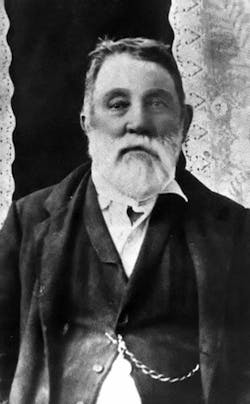The Old West was filled with many colorful characters. Some of the stories are even based on verifiable fact. Others... well, lets just say that self-promotion in those days was about as prolific as cheap alcohol. This brings us to one of the most famous men of law Texas has ever produced: Judge Phantley Roy Bean. To refer to Judge Bean as a man of the law is a stretch. His story is worth mentioning nonetheless.
Roy Bean was born the youngest of three sons to Phantley Roy Bean, Sr., and the former Anna Henderson Gore Mason County Kentucky sometime in 1825. Coming from a destitute family, Roy set out at the age of 15 (or 16, details are sketchy) to find adventure. After hitching a ride on a flatboat to New Orleans, Roy found himself a bit of trouble and fled to San Antonio, Texas, eventually meeting up with his brother Sam. The two embarked on a trading post operation in Chihuahua, Mexico until Roy killed a Mexican gunslinger that was threatening "to kill a gringo". Roy fled to Sonora with his brother to escape Mexican murder charges.
In the spring of 1849 Bean had made his way to San Diego, California to live with his brother Joshua. Joshua Bean was to become San Diego's first elected mayor in 1850. Roy was reputed to be quite a handsome young man and much the womanizer. It seems that women would get Roy Bean in trouble throughout his life. After being arrested to assault with intent to murder, one of Roy's admirers brought him knives in prison hidden in tamales. After using the knives to escape on April 17, he then fled again.
1854 found Bean having relations with a young woman that was being forced to marry a Mexican officer. Bean challenged to man to a duel and killed him. Unfortunately for Roy his friends took umbrage to this and slipped a noose around his neck and left him for dead. Bean's luck must have been with him that day as the horse didn't bolt and the bride-to-be cut him down, but not before he incurred a permanent scar from the ordeal.
In 1861 brother Sam had become the first sheriff of Doña Ana County, New Mexico. Roy joined his brother and opened a store and saloon in Pinos Altos. This is now Grant County, New Mexico.
In October of 1866, Bean would marry eighteen-year-old Virginia Chavez. He would be arrested for aggravated assault and threatening her life within the first year of marriage (see a pattern here?) The pair would eventually reconcile (for a while) and produced four children: Roy Jr., Laura, Zulema, and Sam. They lived in "a poverty-stricken Mexican slum area called Beanville".
Roy was aware that the railroads were headed west, so he sold all his possessions for $900 and purchased a tent and some supplies (by supplies I mean several 55-gallon drums of whiskey). He didn't have to leave his wife as they were separated at the time. By the spring 1882 Roy had set up a makeshift saloon near the Pecos River in a tent city he named Vinegaroon. Within 20 miles of Vinegaroon was over 8,000 railroad laborers.
Since there was really no organized law this far out, a Texas Ranger suggested that there be a law jurisdiction set up in Vinegaroon and Roy Bean was appointed Justice of the Peace for the newly established Precinct Number Six on August 2, 1882. Bean may not have taken this new job seriously but he did refer to a single law text occasionally. It was the only book he had, the 1879 edition of the Revised Statutes of Texas. He refused any new additions or revisions to this text.
His exploits on the bench are where Roy Bean truly became notorious. He did not allow hung juries or appeals and often forced his jurors to buy a round of drinks during court recesses. In many cases Judge Bean's rulings made sense only to him (or his wallet). A typical ruling by Judge Roy Bean went something like "It is the judgment of this court that you are hereby tried and convicted of illegally and unlawfully committing certain grave offenses against the peace and dignity of the State of Texas, particularly in my bailiwick..."
Nearly everyone has heard the story of Bean fining a dead man $40 - it just so happens that $40 was the exact amount that in the corpse's pocket. Less known is the fact that the $40 bought a casket, headstone and paid the gravedigger's labor. Judge Bean did, however, keep the man's gun for use as a gavel.
Several people have confused Judge Bean with Judge Isaac Parker of Fort Smith, Arkansas. Judge Parker was know as The Hangin' Judge and sentenced 172 men to hang and strung up 88. In Jack Skiles book, Judge Roy Bean Country, he explains that Roy never really hung anyone; he was known to sentence then to the gallows but let them escape. I suppose he had a soft spot for some of the criminals in his courtroom.
Bean would become nationally famous in 1898 when a world championship prizefight bout between Bob Fitzsimmons and Peter Maher was held on a sand bar on the Rio Grande, between Mexico and Texas. It seems that Texas and Mexico had both outlawed boxing. The Texas Rangers watched helplessly while Fitzsimmons finished off Maher in 95 seconds. The crowd retired to Roy's saloon after the bout for a few rounds.
On March 19, 1903 at 10:30 PM Roy passed away after a heavy drinking spree. Some say he died because he lost the will to live. Bean could not adjust to the changing times. The thing that pushed him over the edge was the start of construction on a power plant on the Pecos River. He used to say that times were changing and he was being left behind.
About the Author
Charles Bennett
Charles Bennett was born in our Nation's Capital and grew up in the Maryland suburbs. Mr. Bennett has been working in all aspects of the publishing industry since the late 1980s primarily in the fields of commercial photography and magazine production. Moving to California in 1992 to attend college resulted in B.F.A and Masters degrees. California also supplied Mr. Bennett with his wife. The two of them are avid sports persons and participate in shooting, scuba diving, surfing, running and bicycling. As a long time hobby Mr. Bennett has studied the legends of American law enforcement which led to his writing these columns.

